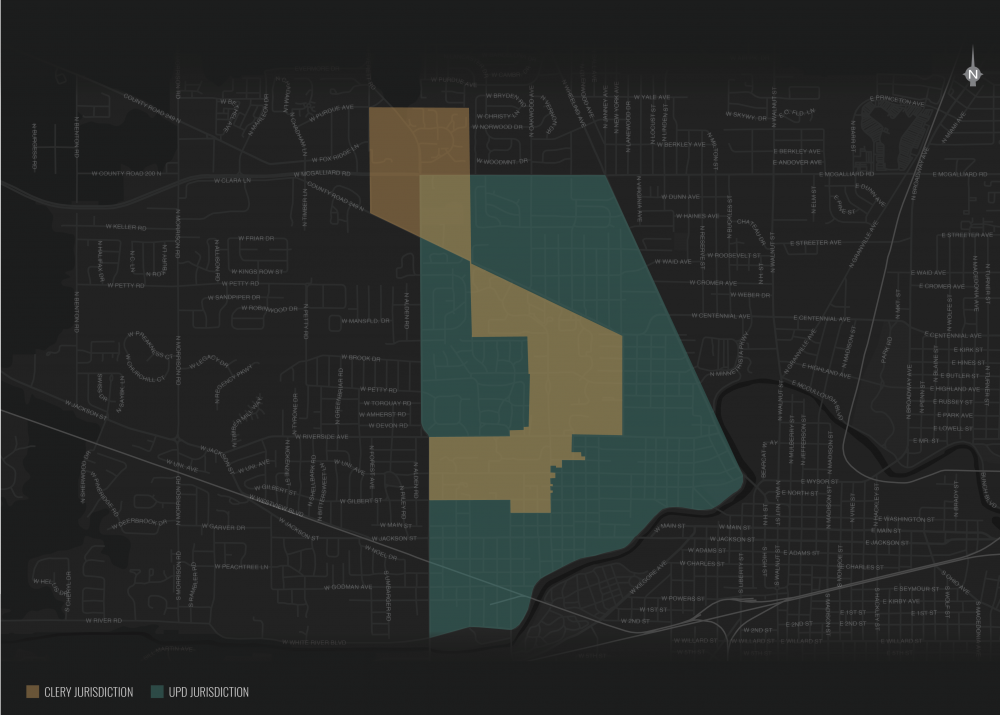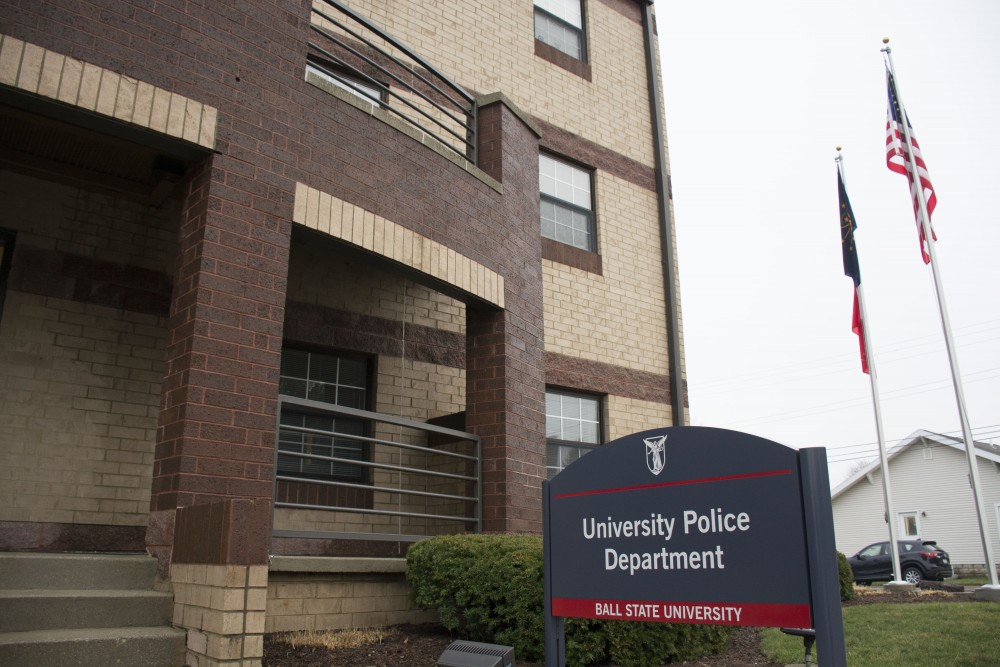

by Allie Kirkman
by Allie Kirkman
Devin Tarr, a senior actuarial science major, did not know.
Amber Grooms, a freshman music education major, did not know.
Neither did Thomas Rasaki, Alexis Jennings, Michael Kummer, Bria Flood, Kyle McDonald, Ruth Schultz or Taylor Paschal.
Despite it being released campus-wide early last month, none of these Ball State students knew what the Campus Security Report is.
The 2018 Campus Security Report (CSR), better known as the Clery Report, published by the Office of Student Rights and Community Standards, includes campus crime statistics and other information about safety awareness, crime prevention, sexual assault prevention and registered sex offenders.
The university, like all public and private postsecondary institutions that participate in federal Title IX student financial assistance programs, is required to publish this information by Oct. 1 every year, in compliance with the Jeanne Clery Act, according to the United States Department of Education. The Clery Act, formerly known as Student Right-to-Know and Campus Security Act, was signed into law in 1990.

Named after 19-year-old Jeanne Clery, who was raped and murdered in her dorm room at Lehigh University in April 1986, the act is a consumer protection law that aims to provide transparency around campus crime policy and statistics, according to clerycenter.org.
But, after nearly 30 years of reporting, experts are mixed on the measurable effectiveness of the law.
While some say it has brought conversations to light that previously could have been swept under the rug, others say crime victims are still left with the burden of reporting an incident. And there seems to be little evidence that prospective or current students pay any attention to the report when considering a school.
Further, some victim advocates argue that increased report numbers don’t necessarily mean an increase in crime. Instead, those numbers can reflect a campus community that has built a culture of reporting, and that, advocates say, is a good thing.
So, does Clery work?
In addition to making the data available to current students and employees, colleges and universities must notify prospective students and employees that the CSR is available.
Laura Egan, senior director of programs at the Clery Center, based in Strafford, Pennsylvania, said “it is extremely beneficial” for students to gain familiarity and awareness with what the annual report contains.


“Annual security reports are a one-stop-shop for information for students,” Egan said in an email. “From understanding how to report a crime, what the alerts they receive on their phones are for and how to get support for themselves or someone they know if they are the victim of dating violence, domestic violence, sexual assault, and stalking — the [campus security report] contains relevant, detailed information for both students and employees that they could need at any time.”
Daniel Carter is president of Safety Advisors for Educational (SAFE) Campuses, an organization that provides training and consultation on safety issues for higher education institutions. Additionally, he is recognized as a national expert on campus crime issues, and he said prior to 1990 when the Crime Awareness and Campus Security Act was established, amending the Higher Education Act of 1965, crime information was kept private.
“Essentially campus crime was a black box. It was sealed off. Campus police records were considered private under [Family Educational Rights and Privacy Act] and students essentially had zero access to campus crime information,” Carter said. “There were very few crime logs being publicized and incident reports were not disclosed.”
Clery changed that.
Now, “one of the underlying purposes of the crime statistics is just to put up and out there that crime happens on campus,” Carter said.
While the numbers are available, the majority of students interviewed did not consider public safety a factor before choosing where to go to college.
Daniel Schultz, a sophomore business administration and sales major, said he did little digging into the crimes reported on and around Ball State’s campus before coming to the university last year.
“I think it was at least a peripheral thought,” Schultz said. “I know and believe that campus is a generally safe place, but I know that unsafe events are going on from alerts and friends around the area.”
According to “The Clery Act: Crime Reporting Concerns,” a 2012 manuscript by Ashley Wood and Steven Janosik, there is no evidence that parents and students are using the Act to make decisions regarding where to attend college, and there are no reports that the Act has had an impact on reducing crime.
Early studies indicated that fewer than 27 percent of students and parents know of the Act and fewer than 25 percent of students acknowledge reading campus crime reports, according to the study.
Egan said it is not uncommon that campus community members are not familiar with what an annual security report is or “are only reading it when a crisis is occurring, either for them or the campus.”
Mike Gillilan, director of student rights and community standards at Ball State, who prepares and submits the crime statistics to the U.S. Department of Education, said the number of reports accessed across campus every year are extremely low.
Despite the university having enrollment of more than 22,000, the number of people seeking out the information is typically only in the mid-teens, he said.
“Does anyone actually pay attention to the Clery report?” Gillilan said. “It’s very disappointing. There's a lot of time and effort and worry and anxiety, at least on my part, that goes into making sure that that's available and it's timely and it's accurate.”
Each year, the U.S. Department of Education conducts reviews to evaluate an institution's compliance with the Clery Act requirements. If there are inaccuracies or omissions with reporting campus crimes, institutions can face fines of up to nearly $56,000 per violation.
University Police (UPD) Chief Jim Duckham said the numbers published in the 2018 Campus Security Report aren’t alarming, rather they are what he would expect.
“Nothing is out of the ordinary,” Duckham said. “When we see the numbers going up in particular areas, I really think it’s the product of the programming and students feeling comfortable to report.”
Duckham credited strong reporting numbers to community policing and other programs like how to protect oneself from domestic violence and rape.
UPD also hosts bike registration programs and Lunch with a Cop — all designed as a way to connect with students.

Nancy Chi Cantalupo, a lawyer and author of numerous sexual misconduct and Title IX research articles, said schools that have active responses and resources for reporting victims and survivors will look like “[they] have a serious crime problem,” but that’s not the case.
“Both national and local statistics indicate that every campus currently has this serious crime problem at a similar rate — a rate that tracks the national incidence,” Cantalupo wrote in a journal article she authored, “Burying our heads in the sand: Lack of knowledge, knowledge avoidance, and the persistent problem of campus peer sexual violence,” published by the Georgetown University Law Center.
“The non-reporting phenomenon and how it is created, however, means that the schools that ignore the problem have fewer reports and look more safe, whereas the schools that encourage victim reporting have more reports and look less safe.”
CSRs were also designed to differentiate and rank institutions. So, based on crime statistics, one college or university may look safer or more dangerous compared to another, which Cantalupo said is a flawed comparison.
Gillilan agreed, saying it isn’t “apples to apples” and that trying to compare may be “foolhardy to do” because of the location of the institution, size of student population and educational culture.
“Much bigger institutions, you would expect their equivalent [reports] to be two to three times higher than ours. Are they? Doubt it. Are they lower? Everybody’s got a different situation,” Gillilan said. “The other thing is, people are not paying attention because they simply don’t trust the numbers.”
In an email, Gillilan said schools with higher crime numbers are often ones that have “greater awareness of resources, good campus programming and wide-spread use of trauma-informed practices in police and Title IX investigations.”
Statistics in the annual Clery Report don’t reflect all crimes that occur on and around campus and there can be disparities in how crimes are reported.
For example, CSR shows the number of rapes reported increased, going from 13 total on-campus incidents in 2016 to 21 in 2017. According to that report, another six were reported as non-campus.
But, according to UPD’s Daily Crime Log, five total rapes were reported in 2016 and 10 in 2017. The log is an updated daily summary of incidents reported to the University Police Department.
Both reports are accurate.
So, why are there disparities between the crime log and the campus security report?
“Different disclosures are meant to serve different purposes,” Carter, SAFE Campuses president, said.
Ball State’ s Gillilan said “it is likely impossible” that crime log numbers will identically match CSR numbers. That is largely because of three factors that affect how, why and where a crime is reported.
For example, if a Ball State student is a victim of sexual assault, they have multiple reporting options. A victim may report the incident to university police, who will then share information with the Title IX coordinator, who reviews and initiates a prompt response. That report to police would be included on the crime log and CSR.
But, if a victim does not want to speak to UPD or pursue a criminal investigation, they may choose to only report to a Title IX officer who will still seek information and offer support. That report would only be included in the CSR.
There is no time limit on reporting assaults to the university.

Another complication is related to whether or not Ball State police are able to conduct an investigation. Within that investigation, an initial report of rape, for example, could be changed to a different type of crime depending on what an officer uncovers through the process.
Finally, Ball State’s Duckham said the two reports use different campus boundaries.
UPD’s patrol area stretches from White River Boulevard to McGalliard Road, then from Tillotson Avenue to Wheeling Avenue. Crimes that occur within these boundaries, even at private residences, would be reported in the daily crime log.
Only crimes occurring within Clery geography would be reported in the CSR. Private residences are not included.
If a student falls victim to a crime outside of UPD’s patrol jurisdiction, Duckham said the department would still help assist and provide resources needed, but the criminal case would be handled by the Muncie Police Department.
Ball State UPD, however, would handle all aspects of a case that occur within its patrol area.
“If [a crime] happened at the Four Hundred Apartments, we would respond to that and it would hit our crime log,” Duckham said. “But it wouldn’t hit our Clery report because it’s not occurring in our Clery geography.”
It’s nearly impossible to determine how many sexual assaults actually happen every year. The majority go unreported for a variety of reasons, according to the Rape, Abuse and Incest National Network, including the fear of retaliation by an assailant and uncertainty over how to report.
Just this semester, four campus-wide Public Safety Advisory alerts have been sent to students regarding sexual assault.
The most recent was Oct. 10 when UPD received a campus security authorities (CSA) report of an attempted sexual assault outside, on the northside of Emens Auditorium, according to the alert. The suspect was described as “a male wearing a windbreaker.”
While no further information was available in the alert, federal law requires CSAs to report non-identifying information about the crime, including the date, the location and type of crime, according to The Office of Victim Services (OVS).
Step In. Speak Up. President Althea McWilliams said the reports the university is seeing are not a bad thing — in fact, she said, it is a good sign.
“As many people know, most sexual assaults go unreported … I believe that more people are reporting rather than more incidents are occurring,” McWilliams said. “Although on the surface it may not look the best, it really is a victory.”
In addition to Step In. Speak Up., Ball State offers many resources to help sexual assault survivors including OVS’ Peer Victim Advocate Team, Sexual Threat Oppression Prevention (STOP) outreach team from the Counseling Center and Rape Aggression Defense System classes.
While efforts are being made on campuses, Cantalupo believes the Clery Act isn’t doing enough to accurately represent crimes that are occurring. She suggests schools conduct public surveys, which could be included in the campus security or crime report.
“If the Clery Act is ever going to attain its original goal of providing prospective and current students and their parents with accurate information about the incidence of sexual violence on a particular campus, it needs to fundamentally change its approach to collecting that information. Specifically, it needs to stop depending on victim reporting,” Cantalupo said in her journal article.
“Schools should be required to administer a standard survey … [that] would ask students questions designed to determine the incidence of sexual violence without depending on individual survivors to come forward to report.”
Gillilan also believes surveys could be an effective tool to measure and remove some of the burden of reporting from victims. However, he is unsure of what the best tool to gather information could be because students receive hundreds of notifications — texts, email, social media alerts — every day.
Additionally, there is no guarantee that a survey would provide what the campus needs to more accurately measure crime numbers, specifically sexual assault.
“One [assault] is too many. Each of these incidents is tragic and has far-reaching consequences not only for the victim, but also the perpetrator and their friends and families,” Gillilan said in an email. “There is a tangible, negative secondary impact on first responders and those who work with the students who are involved.
“As a university, we can never be satisfied with ‘the number’ or be complacent that ‘we’re doing enough’ to prevent sexual assault.”
Even with its imperfections, Gillilan said Clery does its job with alerting the community and bringing attention to crime information that was previously unknown.
“The law is a consumer protection law and it’s been on the books now for 30 years,” Gillilan said. “So, does it matter? I think it does because it has made all of us — especially those of us who are responsible for this — a lot more aware. We now think, ‘How can we not only check off these boxes as far as compliance, but also make it somewhat effective’ and get the word out to make a difference.”
For McWilliams, change starts with students.
“If we want campus to be safer, we have to change the culture. Each individual contributes to our Ball State culture. We have to hold each other accountable to make the right decisions and respect one another,” McWilliams said. “Awareness is one of the steps to change.”
Contact Allie Kirkman with any comments at aekirkman@bsu.edu or on Twitter @alliekirkman15.